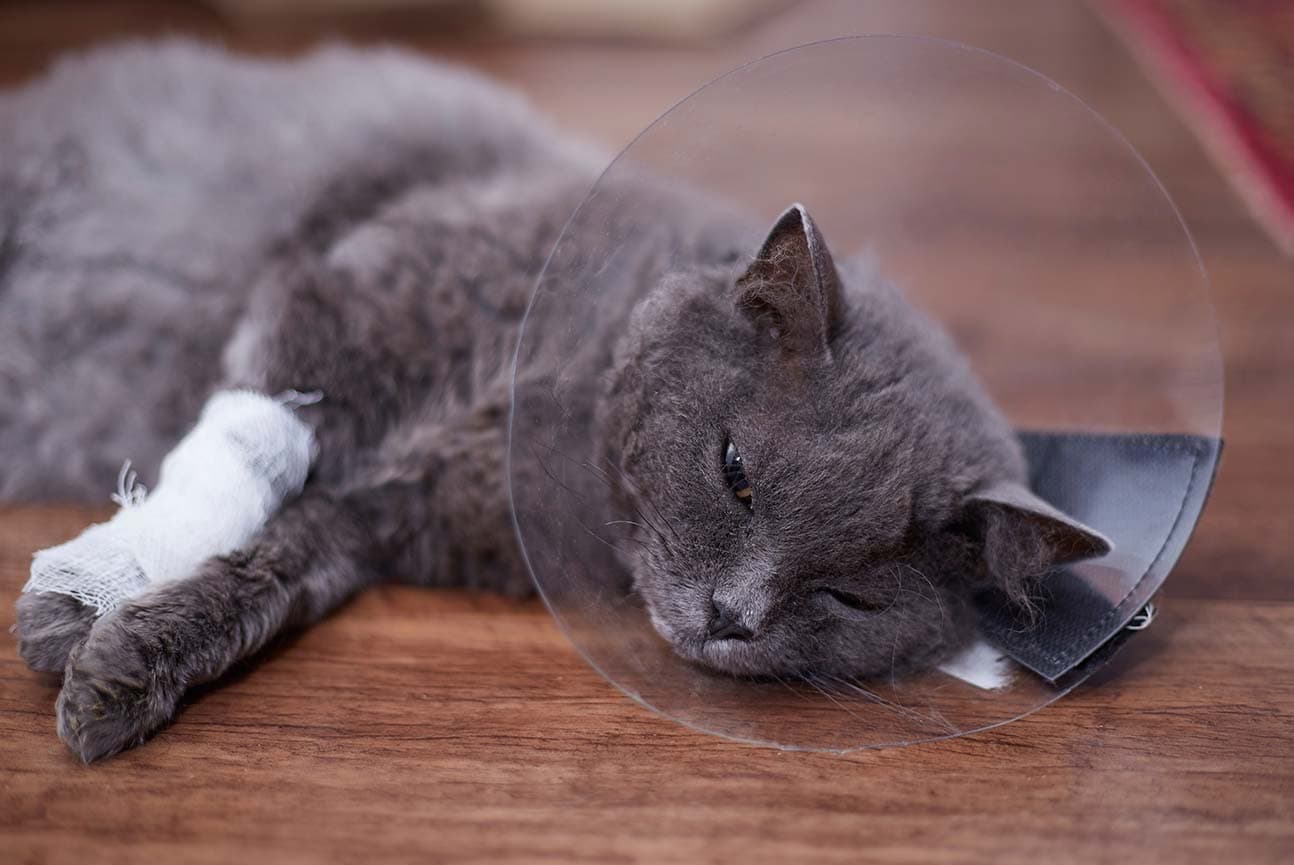Reviewed by Dr. Ionut Rusu
Updated on 13/11/2025
Reading time 4 min.
Overview
Severity: Low
Life stage: All
Broken bones in cats are extremely painful injuries that require immediate veterinary attention. They typically result from falls, road traffic accidents or animal bites. In Dubai’s urban environment, cats face several risks including high-rise balconies, busy roads and extreme temperatures that can cause weakness leading to accidents. If you suspect your cat has a broken bone, handle them gently, avoid manipulating the injury, and seek emergency veterinary care immediately.
Most fractures require surgical treatment rather than casting, but modern veterinary techniques ensure excellent outcomes. With proper treatment and restricted activity during healing, most cats return to normal function within 6-8 weeks. However your cat’s recovery requires your full commitment to restricting their activity, however challenging!
What causes broken bones in cats
Cats can fracture (break) bones for numerous reasons, with falls from balconies being particularly common in Dubai’s high-rise residential areas. Motor vehicle accidents, animal bites and vigorous play can also result in breaks. The city’s intense heat may cause cats to become lethargic or disoriented, potentially leading to accidents.
Not all impacts result in complete fractures. Bones can also suffer hairline cracks or become dislocated from their joints.
The most commonly broken bones in cats include:
- Hindlimb: femur (thigh bone)
- Pelvis
- Forelimb: radius/ulna (forearm bones)
- Spine
- Skull
- Jaw
What are the signs your cat has a broken bone?
Some fractures are immediately obvious, particularly when bone protrudes through the skin. However, many breaks aren’t visible externally, so it’s essential to recognise subtle signs of injury. In Dubai’s heat, cats may already be panting, which can also mask some pain responses.
Key signs to watch for include:
- Holding the affected leg up and refusing to bear weight
- Reluctance to move or change positions
- Signs of pain such as vocalisation, trembling, or hiding
- Swelling around the injury site
- Being quieter than usual
- Loss of appetite or eating less than normal
- Difficulty using the litter tray
- Increased aggression when touched. Pain can cause even gentle cats to bite or scratch
Some cats, depending on the fracture location and type, may still attempt to bear some weight on the injured limb. However, this doesn’t rule out a serious break requiring immediate attention.
Are some cats more prone to broken bones?
Whilst any cat can suffer a fracture, certain factors increase the risk:
- Breed predisposition: Persian and Scottish Fold cats appear more susceptible to fractures
- Age: Kittens have softer, developing bones whilst elderly cats have more brittle bones
- Indoor vs outdoor lifestyle: Outdoor cats face more hazards, although indoor cats risk balcony falls in Dubai’s high-rises
- Body weight: Overweight cats put additional strain on bones
- Underlying health conditions: Cancer, osteoporosis or poor nutrition weaken bones
How do vets diagnose broken bones in cats?
Dubai’s veterinary clinics are well-equipped with modern diagnostic equipment. If your cat arrives with obvious deformity or severe pain, vets will first provide pain relief and stabilisation.
The diagnostic process includes:
- Orthopaedic examination: Hands-on assessment to locate pain, swelling or abnormal movement
- Imaging studies: X-rays are the gold standard for confirming fractures; CT scans may be used for complex injuries involving the spine, pelvis, or skull
Many Dubai clinics offer same-day imaging, allowing for prompt diagnosis and treatment planning.
What can be done to treat a broken bone in cats?
Treatment varies significantly, depending on the fracture’s location, severity, and your cat’s overall health. Unlike human medicine, casts are rarely used in feline orthopaedics due to complications such as poor compliance, skin problems, joint stiffness and muscle wastage.
Most fractures require surgical intervention to achieve the best outcomes:
Surgical repair options include:
- Bone plates and screws for stable, long-lasting repair
- Metal pins placed within the bone’s central cavity
- External fixation: Lightweight frames attached to bones with pins placed through the skin
Following surgery, cats are given appropriate pain relief and can begin walking within a few days. Your vet will typically schedule follow-up examinations 6-8 weeks post-surgery. This check will include X-rays to confirm proper healing before your cat can resume normal activity.
Does a broken bone heal by itself in cats?
Whilst bones possess natural healing capabilities, allowing a fracture to heal without proper veterinary treatment carries substantial risks, not to mention implications for welfare. Without appropriate stabilisation, bones may heal incorrectly (malunion), leading to permanent lameness, chronic pain and increased risk of arthritis.
The dangers of untreated fractures include further instability, worsening of the fracture site, prolonged suffering and long-term joint problems that significantly impact quality of life.
How to help your cat with a broken bone at home
Assisting your cat
During initial recovery, your cat will need help with basic movements. Marble and tile flooring can be particularly slippery for recovering pets.
Consider providing:
- Support slings for mobility assistance and toileting
- Non-slip mats in commonly used areas
- Easy access to food, water and litter trays
Activity restriction
Confinement is essential for successful healing. Create a safe recovery space by:
- Confining to one small room with no furniture to jump on
- Using a large dog crate with comfort essentials if space is limited
- Removing opportunities for jumping onto furniture or balconies
- Providing mental stimulation through puzzle toys to manage boredom
- Installing baby gates to prevent access to stairs or hazardous areas
Physical therapy
Controlled movement helps maintain joint flexibility and muscle tone during healing. Some techniques can be performed at home under veterinary supervision:
- Cold therapy: Apply cold packs wrapped in towels during the first week to reduce swelling and pain
- Range of motion exercises: Gentle joint movement maintains joint health without interfering with bone healing
- Massage therapy: Once initial inflammation subsides, gentle massage promotes circulation and provides pain relief
How to prevent complications after surgery
Surgical complications aren’t common, but can include infection, delayed healing or implant failure. Dubai’s warm, humid climate favours bacterial growth, so it may increase infection risk. Good post-operative care is essential.
Prevention strategies include:
- Strictly adhering to activity restrictions
- Keeping surgical sites clean and dry
- Giving medication exactly as prescribed and directed by your vet
- Attending all follow-up appointments
- Monitoring carefully for signs of complications
Remember, there’s no substitute for proper rest during the recommended healing period. This requires dedicated owner commitment to maintaining restrictions.
When should you be worried about your cat with a fracture?
Contact your veterinary practice immediately if your cat:
- Has obviously broken a limb or been involved in an accident
- Won’t bear weight on a limb and shows pain when touched
- Develops signs of infection around surgical sites: heat, redness, discharge, swelling
- Becomes increasingly lethargic or stops eating
- Shows signs of severe pain or distress
Don’t hesitate to seek immediate help when concerns arise. Professional veterinary guidance and support throughout your cat’s recovery helps ensure the best possible outcome and a return to full, active life.
Suspect your cat has a broken bone? This is a potential emergency that requires immediate veterinary attention. Book an urgent appointment today at Modern Vet Hospital in Dubai, where our skilled team can provide fast diagnostics, pain relief, fracture repair, and dedicated aftercare. With 24/7 emergency services, Modern Vet Hospital is your trusted partner for expert, compassionate feline care when it matters most.
Share this, choose your platform!
Reviewed by
Dr. Ionut Rusu
USAMV, RCVS
Dr. Ionut Rusu is a senior veterinarian with nearly a decade of successful experience in the field. He graduated in 2014 from the University of Agricultural Sciences and Veterinary Medicine (USAMV)…


